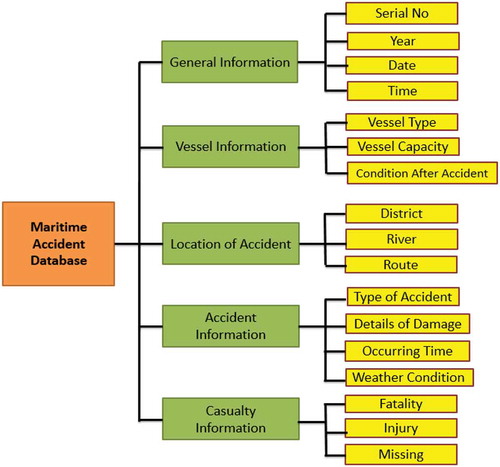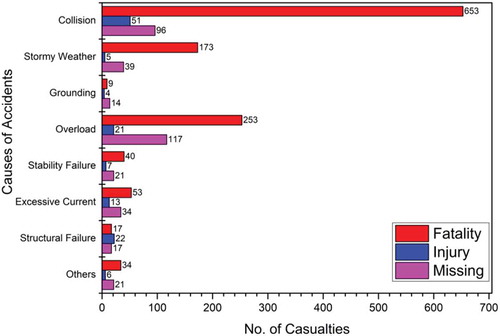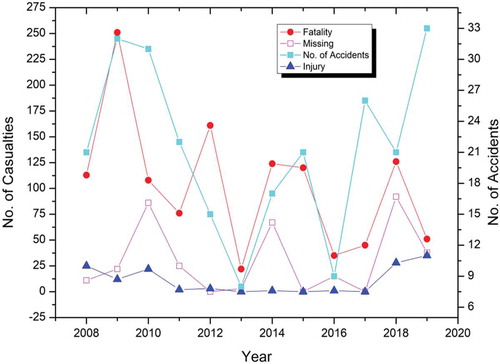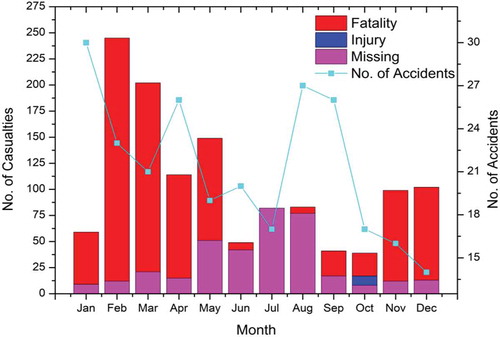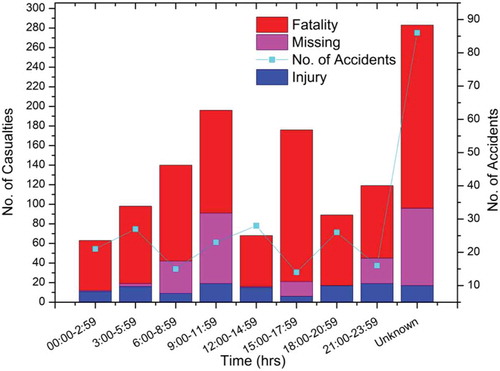ABSTRACT
Bangladesh has a vast network of inland waterways. This allows easier and cheaper transportation to the people of this low-income nation. However, frequent accidents in inland waterways have caused significant loss of human lives and properties. This study analyzes the accident data of an era (2008–2019) collected from the Department of Shipping of Bangladesh. However, it is revealed that due to lack of a proper accident database, many accident parameters and detailed information are not available. The results indicate that most of the accidents and casualties are caused by collision among the vessels. Besides, the predominant portion of overall casualty is fatality. Moreover, 57.6% fatalities take place during the four months of February to May. Furthermore, around half of the accidents are caused by the cargo ships and trawlers. It is also found that the most accident-prone zone is the southern part of the country. Finally, some recommendations are proposed for improvement of inland water transport safety of this low-income country.
Introduction
Bangladesh is a riverine country with nearly 700 rivers and the length of the inland waterway is nearly 24,100 km which is approximately 7% of the overall area of Bangladesh (Banglapedia Citation2021). About 5968 km of inland waterways are navigable during the rainy season, and 3865 km is navigable in the dry season (Bangladesh Inland Water Transport Authority Citation2019). Bangladesh Inland Water Transport Authority (BIWTA) has classified the waterways of Bangladesh into four categories depending on the least available depth. Inland waterway is one of the most useful transport modes in Bangladesh for being the most cost-effective transport mode. Naturally, the waterway system offers acceptable and comparatively cheaper methods of transportation. Likewise, this transportation mode plays a significant role in carrying passengers and freights in Bangladesh. As a result, it is considered as one of the most common modes of transport passengers and products, especially in the southern districts of Bangladesh. On average, nearly 50,000 passengers use different types of inland vessels for travelling to their destination (Department of Shipping Citation2021). Thousands of vessels are travelling through these routes every day. There are many types of inland vessels in the country, such as passenger vessels, ferry, country boats, trawlers, speed boats, sand carriers, cargo carriers, etc. The country has 12,959 registered inland vessels plying in the inland waterways (Department of Shipping Citation2021). The types and numbers of these inland vessels are illustrated in . More than 50% of the total merchandise and one-fourth of the total passenger traffic in Bangladesh is carried by inland water transport. Therefore, the inland water transport sector has a significant contribution to the national GDP of Bangladesh (Bangladesh Bureau of Statistics Citation2018).
Figure 1. Types and numbers of inland vessels in Bangladesh, source: Department of Shipping (Citation2021)
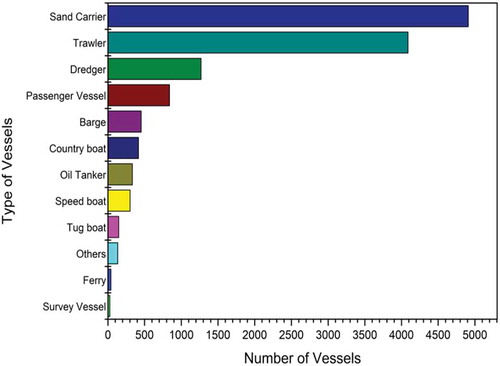
Despite being an important part of the economy and development, this mode of transportation is not being operated in a safer way. Every year significant numbers of accidents are occurring in the inland waterways of Bangladesh. As a result, a lot of people are being killed, getting injured and being reported as missing. Particularly, for the last couple of decades the maritime safety condition of the country has deteriorated extremely. More than 5407 people died in 604 maritime accidents in the last four decades (Akhter Citation2017). To eradicate the number of maritime accidents, the government has taken several actions, and remedial measures but accidents are still happening.
This study aims to reveal the facts and trends of casualties due to maritime accidents in Bangladesh during the era of 2008–2019. The outcomes of this study will put forward some potential measures that should be taken to mitigate the number of accidents and associated casualties in the inland waterway accidents in Bangladesh.
Literature review
Several studies have been conducted on different aspects of maritime accidents and maritime safety in Bangladesh. However, the number of studies available on inland waterway accidents of Bangladesh is inadequate in terms of detailed characteristics of casualties.
Khalil and Tarafder (Citation2004) studied the design and structural features of inland vessels and recommended structural and design improvements to address the ship’s stability. A study by Baten (Citation2005) highlighted the irregularity and discrepancy of safety issues in Bangladesh’s inland water transport system, in particular the operation of inland passenger vessels. Chowdhury (Citation2005) used the Geographical Information System (GIS) in order to analyze the characteristics of accidents related to formal and informal motor-driven passenger vessels in the inland waterways of Bangladesh. Huq and Dewan (Citation2006) studied launch disasters of Bangladesh and found that 2309 people died and 374 people were injured in 248 motor launch accidents from 1977 to 2000. A study by Awal, Islam, and Hoque (Citation2007) revealed that 44% of inland waterway accidents occurred due to adverse weather and overloading. Iqbal et al. (Citation2008) studied passenger vessel safety and recommended improving passenger ship design to prevent capsizing. Awal and Hoque (Citation2008) found that cargo vessels (nearly 25%) are contributing the highest number of casualties. The study analyzed accidents during 1991 to 2005 and showed that the highest number of fatal injuries took place in the year 2003. A study by Azad (Citation2009) revealed that collision is the main reason for maritime accidents from 1975 to 2009. Awal et al. (Citation2007) analyzed 156 maritime accidents and found that most of the maritime accidents occurred due to collision and Nor’wester during the period of 1981 to 2007. A study by Rahman and Rosli (Citation2014) proposed to install digital sensors to detect overloading. The study also suggested some solutions to mitigate overloading problems in passanger vessels. Islam, Rahaman, and Degiuli (Citation2015) found that overloading and adverse weather is the primary cause of maritime accidents during 1980 to 2015. Uddin et al. (Citation2017) analyzed the inland waterway accidents and found that the major cause of inland waterway accidents is collision for the period of 2005 to 2015. The study also revealed that cargo vessels are the dominant types of vessels in maritime accidents, and almost 45% of the vessels foundered after the accidents. An investigation by Probha (Citation2017) found that passenger vessels accounted for the highest percentage (37%) of accidents in inland waterways of Bangladesh during the period of 2008 to 2015. Rahman (Citation2017) analyzed passenger vessel accidents from 1981 to 2015 and found that collision is the main reason for maritime accidents in Bangladesh. The study suggested that every passenger vessel should have the Life-Saving Appliances (LSA) plan approved by the respective authority of the government and have common structural rules that meet the minimum safety requirements (Rahman Citation2017).
This study aims to reveal the pattern of accidents and associated casualties of inland transport accidents of Bangladesh. Therefore, a characteristics analysis will be performed to illustrate the nature of accidents and casualties.
Methodology
One of the significant parts of this research is to collect data from authentic sources. Due to the lack of inland water transport accident database in this developing country, the data collection and database preparation was the most difficult stage of this study. Moreover, the lack of detailed information of accidents has made data processing extremely difficult. the accident data for the period of 2008 to 2017 were collected from the Accident Research Institute (ARI) of Bangladesh University of Engineering Technology (BUET). The primary source of this data is the Department of Shipping (DOS). Besides, the accident data of the year 2018 and 2019 were collected from some renowned daily newspapers of Bangladesh. During data collection from the Department of Shipping, it was observed that this organization generally collects and stores data for legal purposes only. As a result, it was very much cumbersome to sort out scientific data from the reports. However, an authentic database is very much needed to analyze inland waterway accidents. Uddin et al. (Citation2017) developed a database of maritime accidents, and a database similar to that is developed for this study. The database consists of five main categories and seventeen subcategories as illustrated in .
A total of 256 inland waterway accidents that occurred from 2008 to 2019 has been analyzed in this study. Casualties of inland waterways in those accidents have been analyzed through Microsoft Excel and illustrated in graphical and tabular forms. Attempts have been made to keep the representation of the results as clear and unambiguous as possible.
Results and discussion
The results of characteristics analysis of the accident types, distribution of casualties based on accident types, annual distribution of casualties, month-wise distribution of casualties, type of vessels in accidents, location of accidents, and time of occurrence of accidents in inland waterways is presented in both graphical and tabular forms in this section.
Type of inland waterway accidents
Seven major types of accidents have been identified in this analysis, such as collision, stormy weather, grounding, stability failure, excessive current, and structural failure. The analysis indicates collision as the leading cause of inland waterways accidents. From 2008 to 2019, 61.72% of total accidents occurred due to collisions. The probable reasons behind these accidents could be lack of awareness of master and crews, insufficient communication equipment, inadequate lighting arrangements, etc. Moreover, there is unhealthy competition among the drivers that result in a collision between two vessels. However, these reasons are not mentioned in the accident reports of the Department of Shipping and ARI. It was found that 94% of collision takes place by the vessels contact with each other during the study period. Stormy weather is responsible for 9.77% maritime accidents in Bangladesh. During stormy weather, the strong winds exert pressure on the vessel which hampers the stability and tends the vessel towards capsizing. Furthermore, grounding and overloading are responsible for 7.81% and 5.47% of accidents respectively. Besides, stability failure (3.91%), excessive current (3.52%), structural failure (0.78%), and others (7.03%) have a comparatively minor impact on inland waterway accidents.
Distribution of casualties based on accident types
The most prominent feature of water transport accidents in Bangladesh is that they are extremely fatal in nature and result in more casualties than any other transportation mode in the country (Probha Citation2017). illustrates the casualties based on accident types. It is observed that 653 of people died due to collision which is almost 53% of the overall death toll. Moreover, 46.5% of overall casualty occurs due to collision. Apart from that, noteworthy number of people died in overloading and adverse weather conditions accidents. The fatality per accident ratio was 4.13, 18.07, and 6.92 for the accidents due to collision, overloading, and stormy weather respectively. Although the maximum number of people died due to collision among the vessels, however the maximum fatality per accident ratio was found for the accidents due to overloading and stormy weather. The foremost probable reason behind these accidents could be the lack of life-saving appliances such as life-jackets, lifebuoys and life rafts and so on inside the ships. It is worth mentioning that there is no legislation or law for keeping those life-saving appliances inside the ship. Besides, during adverse weather conditions, most of the vessels lose stability and result in capsizing. It is also revealed that the proportion of fatalities is higher than injuries. The figure also illustrates that many people were reported as missing due to overloading and collision.
Yearly distribution of accidents and casualties
The result of the yearly distribution of accidents and casualties has been presented in . It is observed that fatality rates accounted for a significant percentage of the total casualties. Due to 256 inland waterway accidents during the era of 2008 to 2019, 1232 persons died, 129 persons were injured and 359 persons were reported missing. Therefore, it is revealed that around 71.6% of overall casualty is fatality. It is also evident that the highest number of accidents occurred in the year of 2019, and the maximum number of people died in 2009. In addition, the maximum number of injuries and missing of people were reported in 2019 and 2018 respectively. Although the fatality rate is decreasing to some extent, however the number of accidents and the injured people is increasing in recent years.
Month-wise distribution of accidents and casualties
depicts the monthly distribution of accidents and injuries that occurred in inland waterways from 2008 to 2019. It is observed that the higher proportion (around 42.59%) of accidents occurred in January, April, August, and September. It is also revealed that the fatality rate was comparatively higher (around 57.6% of overall fatality) during the months of February to May. Besides, a significant portion of injuries took place during the months of May to August.
Type of vessels involved in inland waterway accidents
Different types of vessels move in the inland waterways of Bangladesh. These vessels or watercrafts can be categorized into four major groups as shown in . Among those, the highest percentage (48.44%) of accidents occurred by cargo ship and trawlers. Besides, passenger ships experienced noteworthy percentage (37.49%) of accidents during 2008–2019. Besides, the types of 12.89% vessels are not mentioned in the accident reports which is a major deficiency of accident investigation and reporting system of the country.
Table 1. Types of vessels involved in inland waterway accidents
Temporal distribution of accidents and casualties
shows the temporal distribution of inland water transport accidents and casualties. It is observed that the accidents are occurring all around the day. However, the time of a significant percentage of accidents (33.6%) is unknown due to the lack of proper accident investigation and documentation. Besides, nearly 10.95% of accidents occurred during 12:00–15:00 hrs. The probable reason behind this can be the unwillingness of the drivers and crews to obey the rules and regulations of BIWTA even in daylight. Almost 10.54% of accidents took place in 3:00–6:00 hrs i.e., at late night. However, it is also very alarming that maximum accidents are occurring at the daytime. It is also seen that the time of occurrence of a relatively higher percentage (22.97%) of fatalities is unknown. Apart from that, the fatality rate was comparatively higher during 9:00–11:59 hrs and 15:00–17:59 hrs. also illustrates that around 14.72% of injuries occurred between 9:00–11:59 hrs compared to about 13.17% during the unknown time. However, the portion of missing people was reasonably higher than the rate of injuries but lower than the rate of casualties during 2008–2019.
Location of inland waterway accidents
shows that the maximum number of inland waterway accidents took place in the Barishal district. Besides the districts namely Chattogram, Khulna, Chandpur, Munshiganj, and Dhaka are noteworthy for the occurrence of accidents. It is observed that the southern zone of the country is mainly vulnerable to the occurrence of accidents. It is also observed that the maximum number of fatalities accounted for the accidents those occurred in Munshiganj. Moreover, accidents in Kishoreganj, Barishal, Bhola, Manikganj and Dhaka districts has faced a striking number of fatalities. Apart from that the maximum number of injuries in the inland waterway accidents occurred in Patuakhali, Barishal, and Chandpur respectively.
Table 2. Inland waterway accident-prone districts
Research findings
The findings of this study can be summarized as follows:
Collision is responsible for 61.7% inland water transport accidents, 53% fatalities and 46.5% casualties.
The maximum share of overall casualty is fatality.
Around 57.6% fatalities occur in only four months of February to May.
Almost half (48.44%) of the inland waterway accidents occurred by cargo ship and trawlers.
The time of significant percentage (33.6%) accidents are not reported due to improper accident investigation and documentation system of the country.
The southern zone of the country is highly vulnerable to inland water transport accidents.
Conclusion and recommendations
Being an over-populated country, the demand for inland waterway transportation is always growing in Bangladesh. Thousands of people are using waterways for being the cheapest mode of transportation in this low income country. Considering this importance, immediate steps should be taken to improve safety in the inland waterways. Based on this study, some recommendations for strengthening inland waterway safety can be summarized as follows:
Collision accidents can be avoided by improving the adequate lighting facilities, increasing horn and whistling facilities, creating awareness among masters and crews, and avoiding foggy weather conditions.
Proper training should be given to the masters and crews so that they can handle emergency situations. Skilled maritime professionals should be made to improve the maritime sector.
Weather forecasting systems should be improved in all types of inland vessels. Communication devices such as radar, radios, and VHF must be ensured in all types of vessels.
Inspection of overloading must be done before starting all voyages of the vessels. The vessel owners should be penalized for overloading conditions. Carrying commercial cargoes in passenger vessels should be strictly prohibited.
Sufficient life-saving equipment such as lifebuoys and life jackets should be ensured inside the vessels. Moreover, all vessels must have fire protection equipment such as fire extinguishers, fire alarms, etc.
The inland shipping ordinance act of 1976 must be implemented strictly by the Department of Shipping and BIWTA. The Department of Shipping and BIWTA should appoint adequate skilled maritime professionals to serve the inland waterways.
Vessels must be designed by following the rules and regulations of the Department of Shipping. All surveys related to the vessels should be ensured properly in due time. Inspection of the engine, hull, and machinery should be done on a regular basis before the voyage.
Effective accident investigations should be conducted so that the actual reason can be determined and necessary steps can be taken for improvement. A database of inland waterway accidents must be developed with sufficient parameters by the respective authorities of the government of Bangladesh.
Mass awareness should be created among the people. All the passengers on board should be able to use the life-saving equipment during emergency situations. In this regard, the government should provide coverage of some awareness videos through the media.
Disclosure statement
No potential conflict of interest was reported by the author(s).
References
- Akhter, S. 2017. “Unregistered Vessels Put Public Safety at Risk”. Accessed 05 January 2021. http://www.newagebd.net/article/15986/unregistered-vessels-put-public-safety-at-risk
- Awal, Z. I., and M. M. Hoque 2008. “Some Aspects of Water Transport Accident and Injury Problems in Bangladesh.” In proceedings of the 10th Pacific Regional Science Conference Organisation (PRSCO) Summer Institute, Dhaka, Bangladesh, pp. 15–17.
- Awal, Z. I., M. R. Islam, and M. M. Hoque 2007. “ Marine Vehicle Accident Characteristics in Bangladesh: Study on Collision Type Accidents.” In Proceedings of the 7th International Conference on Mechanical Engineering, Bangladesh University of Engineering and Technology, Dhaka, Bangladesh, paper no. 46.
- Azad, A. K. 2009. “Riverine Passenger Vessel Disaster in Bangladesh: Options for Mitigation and Safety”. Master’s Thesis in Disaster Management, BRAC University, Dhaka.
- Bangladesh Bureau of Statistics, 2018. “Gross Domestic Product (GDP).” Accessed 06 January 2021. bbs.portal.gov.bd/sites/default/files/files/bbs.portal.gov.bd/page/057b0f3b_a9e8_4fde_b3a6_6daec3853586/F2_GDP_2017_18.pdf
- Bangladesh Inland Water Transport Authority, 2019. “About Us.” Accessed 05 January 2021. http://www.biwta.gov.bd/site/page/aea3e3d9-0e99-4bcd-9330-a0a9961c793c/aboutus
- Banglapedia, 2021. “River and Drainage System- Bangladesh.” Accessed 06 January 2021. http://en.banglapedia.org/index.php?title=River_and_Drainage_System
- Baten, A. S. M. A. 2005. “Internal Water Transportation System: Safety of Inland Passenger Vessels.” NDC Journal 4 (1): 131–157.
- Chowdhury, A. S. 2005. “Waterway Accident Characteristics Assessment and Information System Development”. Master of Engineering Thesis, Bangladesh University of Engineering and Technology, Dhaka.
- Department of Shipping, 2021. “Number of Inland Ships”. Accessed 05 January 2021. http://dos.gov.bd/site/page/b21776b6-64b1-4ff4-86bf-92f0eec77e28/-
- Huq, N. A., and A. M. Dewan. 2006. “Launch Disasters in Bangladesh: A Geographical Study.” Geografia: Malaysian Journal of Society and Space 1 (2): 14–25.
- Iqbal, K. S., G. Bulian, K. Hasegawa, M. M. Karim, and Z. I. Awal. 2008. “Possible Remedies for Intact Stability Hazards Involving Contemporary Small Inland Passenger Ferries in Bangladesh.” Journal of Marine Science and Technology 13 (3): 282–290. doi:10.1007/s00773-008-0023-4.
- Islam, M. R., M. D. Rahaman, and N. Degiuli. 2015. “Investigation of the Causes of Maritime Accidents in the Inland Waterways of Bangladesh.” Brodogradnja/Shipbuilding Journal 66 (1): 12–22.
- Khalil, G. M., and M. S. Tarafder. 2004. “Ferry Disasters in the Rivers of Bangladesh: Some Remedial Measures.” The Journal of National Oceanographic and Maritime Institute 2 (2): 33–53.
- Probha, N. A. 2017. “A Study on Transport Safety Perspectives in Bangladesh through Comparative Analysis of Roadway, Railway and Waterway Accidents.” M. Sc. Engg. Thesis, Department of Civil Engineering, Bangladesh University of Engineering and Technology, Dhaka.
- Rahman, N. A., and H. Z. Rosli. 2014. “An Innovation Approach for Improving Passenger Vessels Safety Level: Overload Problem.” International Journal of Business Tourism and Applied Sciences 2 (2): 1–14.
- Rahman, S. 2017. “An Analysis of Passenger Vessel Accidents in Bangladesh.” Procedia Engineering 194: 284–290. doi:10.1016/j.proeng.2017.08.147.
- Uddin, M. I., M. R. Islam, Z. I. Awal, and K. M. S. Newaz. 2017. “A Study of Inland Water Transport Accidents of Bangladesh: Lessons from A Decade (2005–2015).” Procedia Engineering 194: 291–297. doi:10.1016/j.proeng.2017.08.148.
- Uddin, M. I., and Z. I. Awal. 2017. “An Insight into the Maritime Accident Characteristics in Bangladesh”, 1st International Conference on Mechanical Engineering and Applied Science, Military Institute of Science and Technology, Dhaka, Bangladesh, Vol 1919, paper no. 02001.

